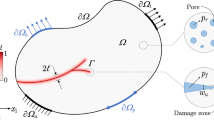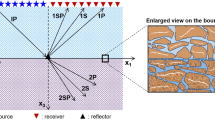A study is made of a two-dimensional bound problem on slow motions of a liquid in a hydraulic fracturing crack and on deformations and filtration caused by these motions in a poroelastic medium with double porosity involving two components — the porosity proper and jointing. The motions are induced by the pumping of a liquid into a well. The motion inside the crack is described by hydrodynamics equations in hydrostatic approximation. Some ordered sequence of interdependent geomechanical processes occurring on hydraulic fracturing is established in conformity with the principle of incomplete connection. In the main space surrounding the crack, the liquid moves in the porous component of the two-phase medium. In the boundary layer the motion dominates in the jointy component. In distinction to the classical problem with double porosity, the indicated problem is solved rigorously with account for elastic deformations of the skeleton. The motion regimes in the main volume and in the boundary layer differ significantly due to the permeability of the medium.
Similar content being viewed by others
References
M. A. Biot, Mechanics of deformation and propagation in porous media, J. Appl. Phys., 33, No. 4, 1482−1498 (1962).
F. Gassmann, Uber die Elastizitat porozer Medien, Mitteiluagen aus dem, Inst. für Geophysik, Zürich (1956), Vol. 17, pp. 1–23.
J. Rice, The Mechanics of Seismic Center, Mir, Moscow (1982).
R. K. Wilson and E. C. Aifantis, On the theory of consolidation with double porosity, Int. J. Eng., 20, No. 9, 1009–1035 (1982).
E. Detournay and A. H.-D. Cheng, Fundamentals of poroelasticity, Chapter 5 in: C. Fairhurst (Ed.), Comprehensive Rock Engineering: Principles, Practice and Projects, Vol. II. Analysis and Design Method, Pergamon Press, Oxford, UK (1993), pp. 113−171.
O. Coussy, Poromechanics, J. Wiley & Sons, Ltd., England (2004).
G. I. Barenblatt, V. M. Entov, and V. M. Ryzhik, Motion of Liquids and Gases in Natural Beds [in Russian], Nedra, Moscow (1984).
A. V. Karakin, Problem of hydraulic fracturing in the upper layers of the crust, Fiz. Zemli, No. 8, 27–42 (2006).
A. V. Karakin, M. M. Ramazanov, and V. E. Borisov, Problem of incomplete connectedness of hydraulic fracturing equations, Mat. Modelir., 29, No. 6, 115–134 (2016).
A. V. Karakin, M. M. Ramazanov, V. E. Borisov, I. S. Men’shov, and E. B. Savenkov, Self-similar solution of the problem on HFB crack for a poroelastic medium, Mat. Modelir., 29, No. 4, 59–74 (2016).
J. I. Adachi and E. Detournay, Plane strain propagation of a hydraulic fracture in permeable rock, Eng. Fract. Mech., 75, 4666–4694 (2008).
N. I. Muskheshvili, Some Basic Problems of Elasticity Theory [in Russian], Nauka, Moscow (1966).
Author information
Authors and Affiliations
Corresponding author
Additional information
Translated from Inzhenerno-Fizicheskii Zhurnal, Vol. 93, No. 4, pp. 809–818, July–August, 2020.
Rights and permissions
About this article
Cite this article
Karakin, A.V. Formation of Crack on Hydraulic Fracturing of Bed in a Medium with Double Porosity. J Eng Phys Thermophy 93, 781–789 (2020). https://doi.org/10.1007/s10891-020-02179-4
Received:
Published:
Issue Date:
DOI: https://doi.org/10.1007/s10891-020-02179-4




